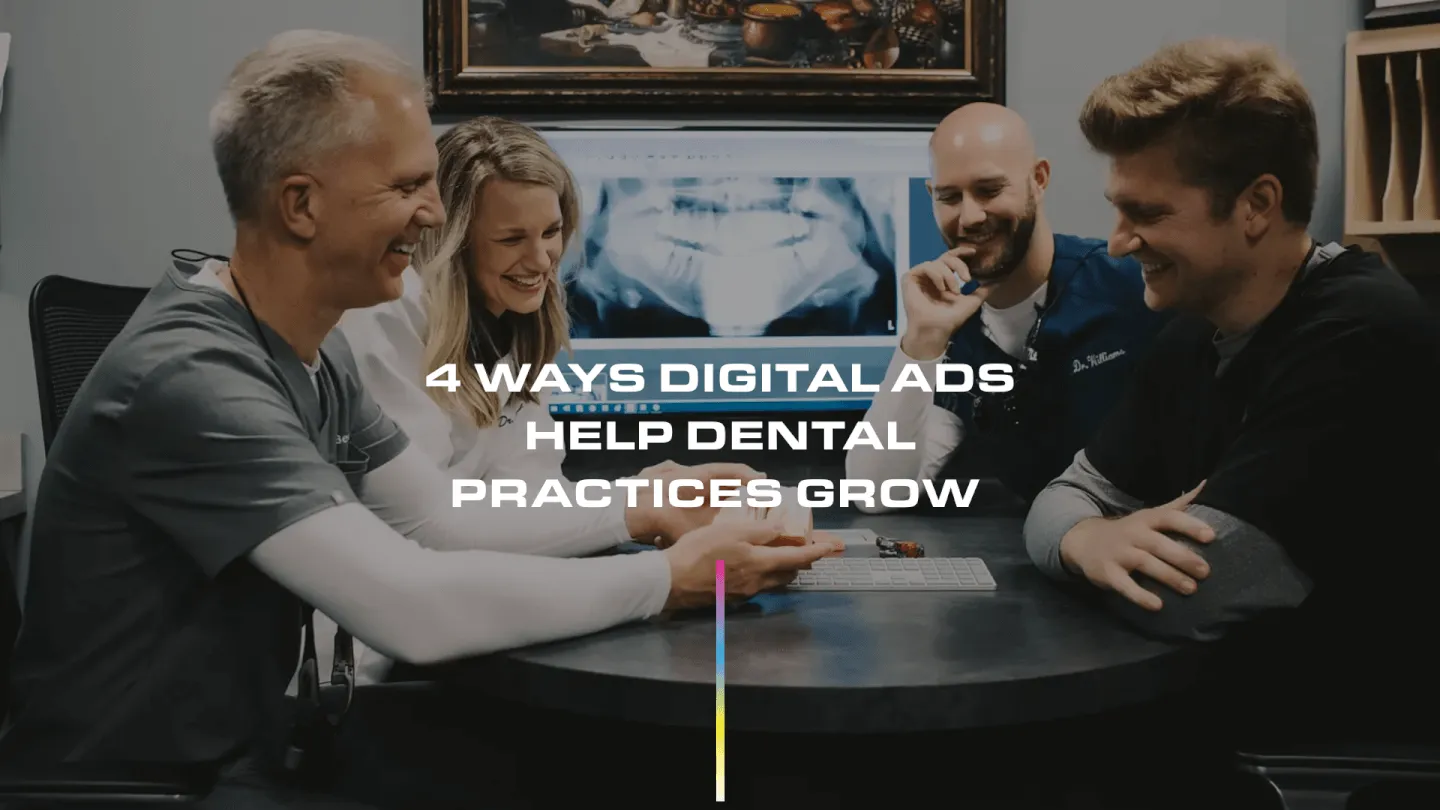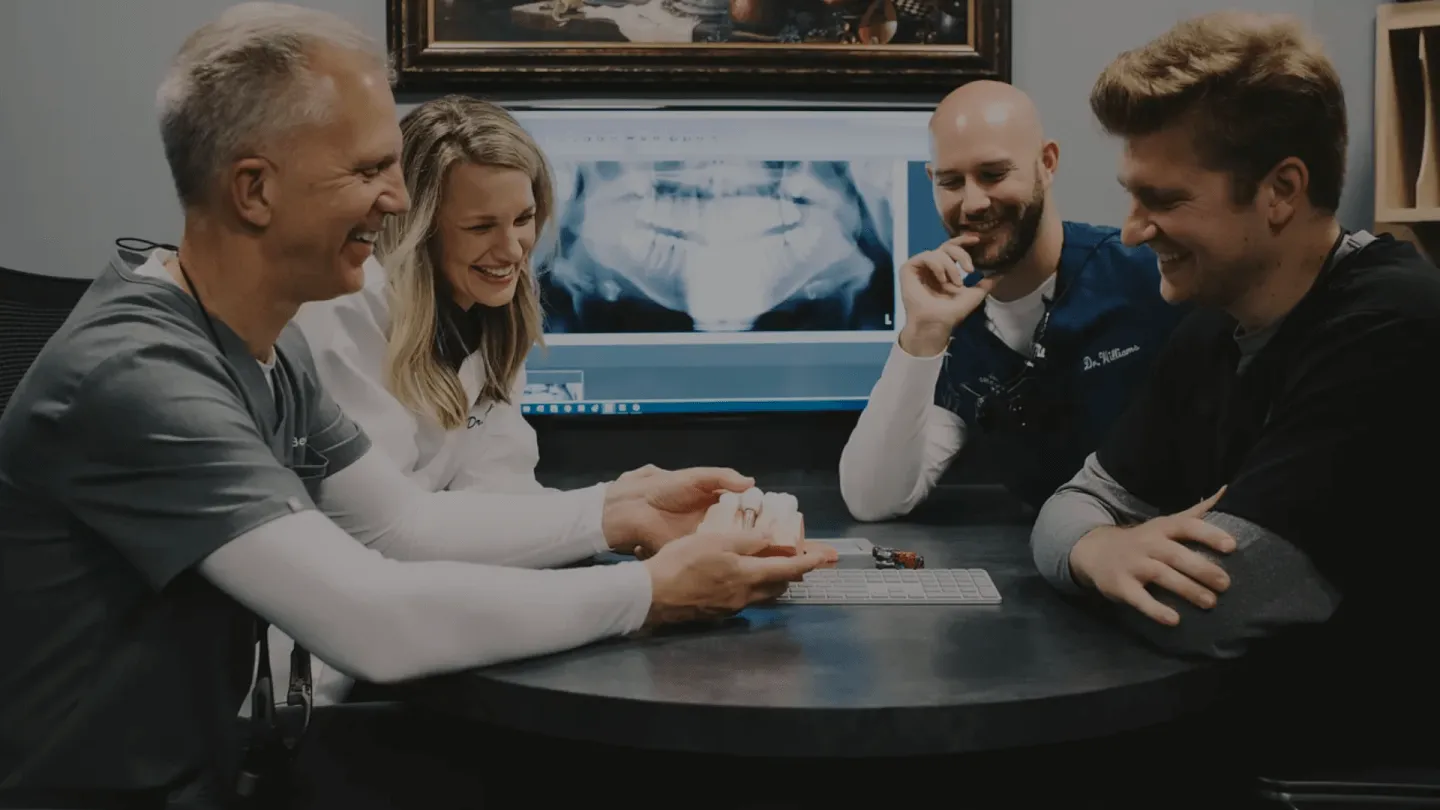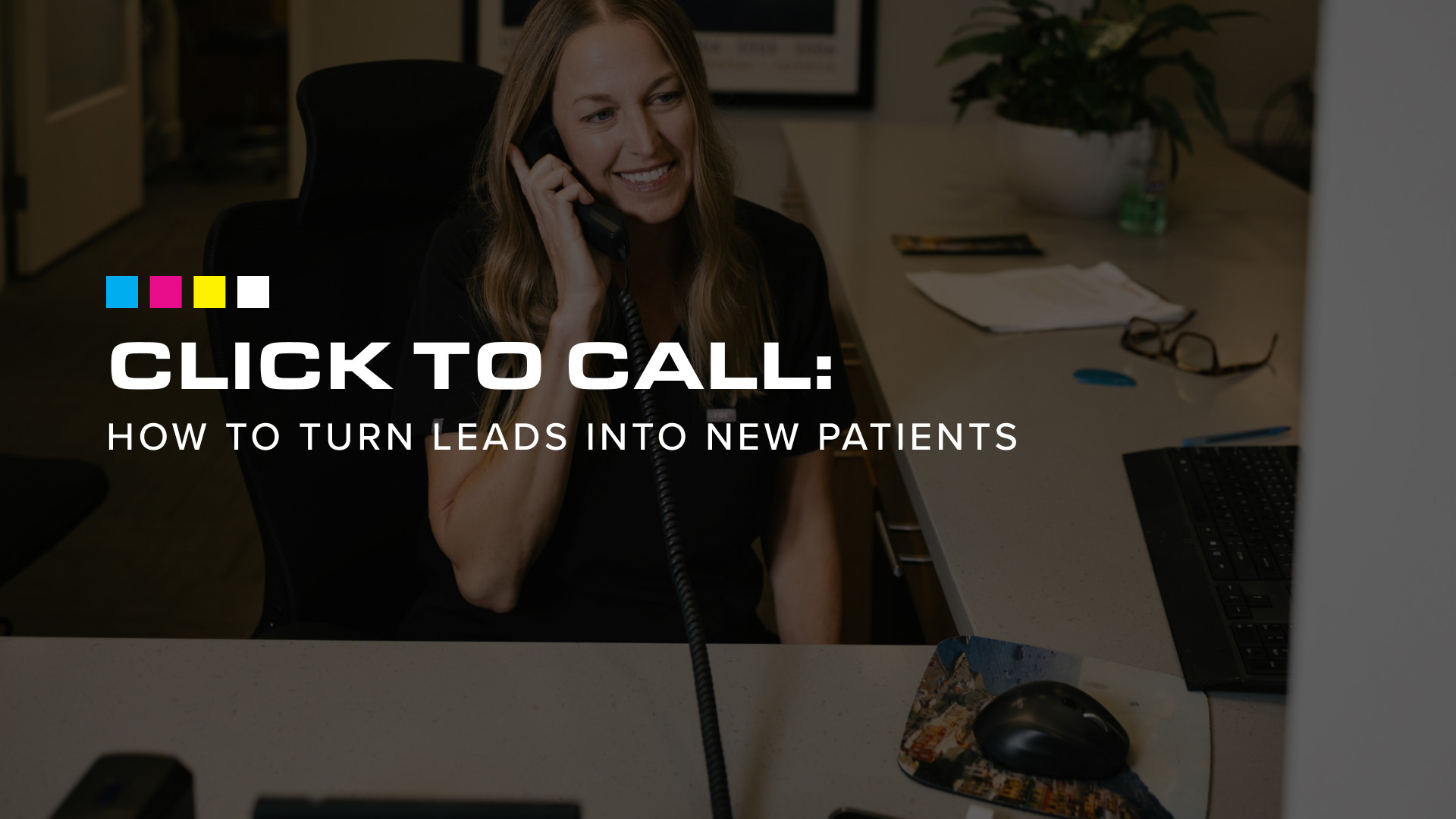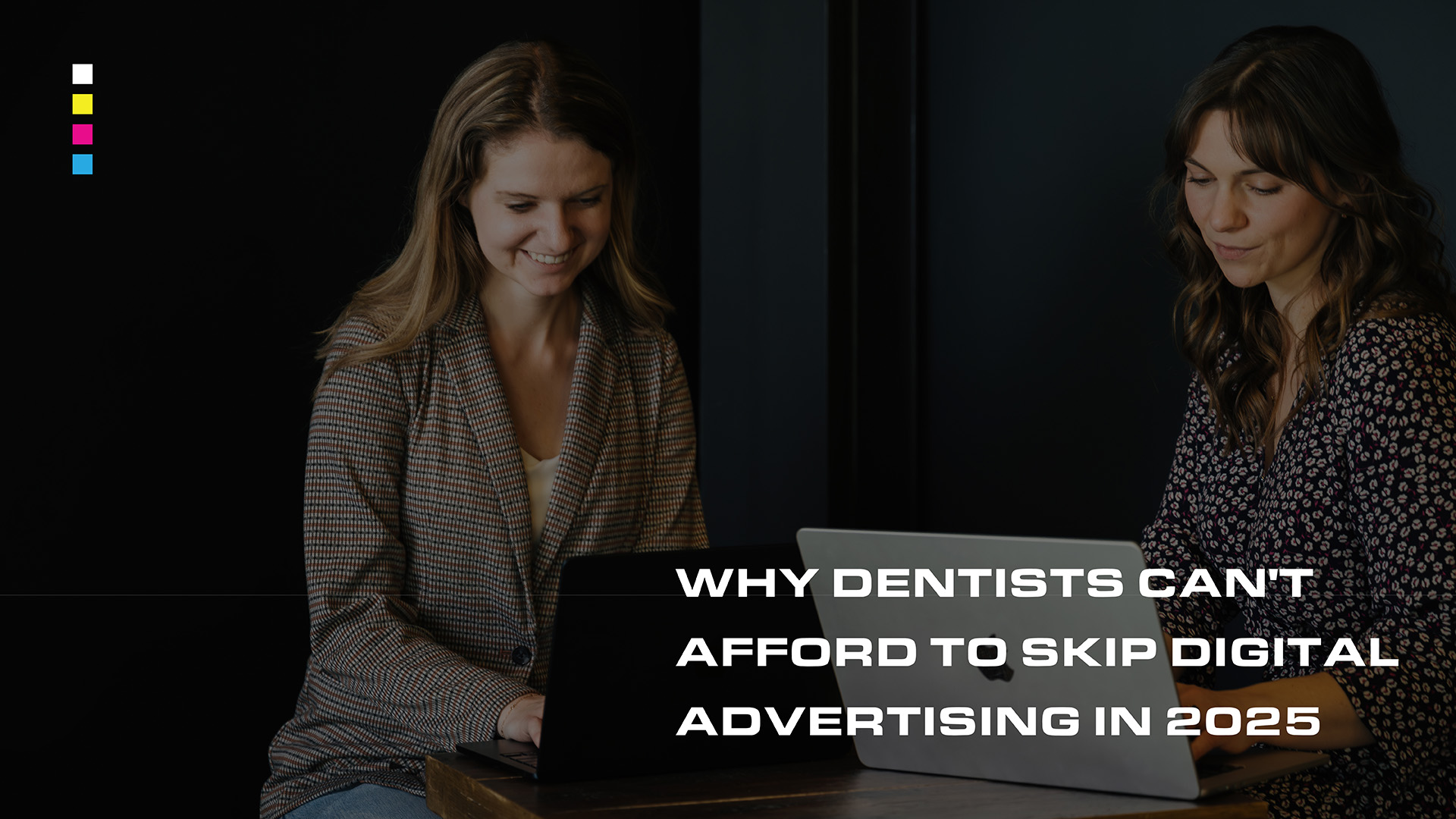4 Ways Digital Ads Help Dental Practices Grow
Digital ad campaigns are a tried and true opportunity that dental practices across the country have been taking advantage of for years. Whether it’s a Google search campaign targeting new patients in your area, a Facebook or Instagram brand awareness approach, or a fully-integrated dental implants campaign, every practice should be thinking about digital ads as a requirement for their 2022 growth, and beyond.
Yet, we hear it all the time: “Google ads don’t work,” or “You can’t get any new patients on Facebook.” A lot of practice owners believe that the sole purpose of digital ads is to simply “get butts in the chair.” And while we understand that perspective and the desire for ROI, it’s a one-sided way to approach your brand and market share opportunities that come from a well-rounded digital ad strategy.
How do digital ads help dental practices grow?
1. Exposure
There is no less expensive way to get exposure in the digital space than digital advertising. No, really.
That’s why many dental practices have made hundreds of thousands of dollars in revenue using the strategy to their benefit. Appreciate the fact, for a moment, that for about $2 - $10 per click, you can get someone to not only see your ad, but then click through to your website, opening up a wealth of opportunity to create a meaningful impression, and gain a new patient. That type of exposure for people searching directly for dentists in their area, for so little money, has never been so accessible.
Now, if your ads aren’t relevant or your website is in serious need of upgrading, that investment into exposure is likely being wasted. The good news is that if you do have a strong brand message and great website experience, your risk for wasting investment dollars is cut down to virtually zero. And I get it, maybe it doesn’t feel like it’s all paying off in the first 30-90 days. But let’s be honest, as with most marketing efforts, these things take a little more time than that. It’s undeniable that the cumulative effect over the next 1-3 years will generate more momentum (and exposure!) for your practice than you can imagine.
2. Supplemental Marketing
Here’s a hard truth: digital ads are meant to be supplemental. Meaning, supplemental to your branding, website experience, great patient care, word of mouth referrals, community involvement, social media outreach, etc.
“I’ve got 6 months, so these ads better work,” is a strategy destined to fail. While they are incredibly effective, and often offer a lot quicker ROI, it’s still unwise to approach a digital ad strategy as the end-all marketing for your practice. Digital ads are not going to save a failing practice, no matter how many dollars you throw at it.
Marketing is the power of a thousand little drips. It takes an investment of time as well as dollars, thoughtfulness and care for your strategies and how they relate to each other, and a critical, well-rounded view of your total patient experience.
3. Website Traffic
Here at Studio EightyEight, our average digital ad campaign targeting new patients in a GP office starts at $1,500/month. We routinely see between 500-1,000 unique visits to the website per month for that investment. (The range is usually dependent on how competitive the area is that we’re targeting.) Remember how we talked about exposure? 500-1,000 maybe doesn’t seem like a lot on paper, but I bet if 500-1,000 potential patients walked into your practice right now, you’d be floored.
Now, not all of those 500-1,000 potential new patients are ready to buy or make any decision. Lots of folks are probably still in the research phase of the buying cycle, and that’s ok. We know that a good website experience will stick with them, and make them want to come back (we also smartly use Remarketing tools to help nudge people in the right direction, too.)
Imagine the number of potential patients that will “tip” to your practice in the next 2 or 3 years, all thanks to well-placed ads and a “wow” website. If you’re only thinking about how effective your digital ads are on a monthly, or quarterly basis, you’re missing out on the limitless potential for momentum over the long-term, too. Let’s not lose foundational marketing principles: it can often take 7-18 “touches” before a patient schedules an appointment. Digital ads are a multi-touch strategy.
4. Location, location, location
Digital location, that is. Being at the top of Google is prime real estate. If you’re there, a competitor can’t be. Alternatively, if you're not there, your competition is. It’s as simple as that.
Even if you have good SEO (good organic website placement and one of the top 3 business listing spots on the local search results) it’s still a worthy investment to implement digital ads. Think about it this way: most people will see 5-7 listings on their screen when they search for a dentist. If you’re placed in all 3 major search areas (digital ads, local results, and organic listings), you’re securing essentially 43%-60% of the digital real estate available. There’s the obvious benefit of a higher click-through rate, as well as the authoritative value that improves potential patients’ perception of your practice before they’ve even seen your website or picked up the phone.
What is an effective budget for a digital ad campaign?
Normally when we talk about digital ads, there are 2 major questions that go hand-in-hand: “are they effective?” and “how much do I spend?”
Since we’ve covered the first question, let’s dive into the second one that’s equally important.
It all starts with a formula
Budget is everything when it comes to running an effective digital ad campaign. We’re at a point in the digital marketing space where digital ad campaigns are no longer foreign to most business owners. It’s expected that you’ve probably already run an ad campaign, and perhaps had a failed attempt at it. More often than not, that failure had to do with budget.
8 years ago $250-$500/month might have cut it for a well-rounded digital ad campaign, but these days, with Google and Facebook being the largest advertising platforms in the world, that’s just not enough. For comparison, think back to when places like NBC and ABC were the largest advertising platforms in the world - that would be like spending $500/month for a TV campaign and then saying it didn’t work because you didn’t get any new patients. Smart marketers at the time would know right away $500/month is nowhere near an effective budget for TV.
So since we consider ourselves smart marketers, we’ll give you some inside tips. A baseline budget for an effective new patient campaign for a GP practice should start around $1,500/month ($18,000/year). Let’s consider the TV comparison again, shall we? Can we all agree that TV campaigns cost more (like, a lot more) than that, and are nearly impossible to track for ROI?
When spent right, that $1,500/month budget gives you enough exposure to be seen by enough people (1,500-2,000) to generate enough clicks (500-750), to get the phone calls you want (25-30). And, bonus, you can track it with real data. But overall, you can see how there’s a certain level of math involved to open the funnel wide enough to get conversions at the other end.
Alternatively, a more specialized campaign focused on services like dental implants or Invisalign will require a higher budget to compete. This is simply because the search volume is lower, therefore competition is higher, and the average cost per click goes up. We typically recommend $2,500-$3,500/month for specialty campaigns such as this. A larger budget might also be necessary for some GP practices looking for new patients if they’re located in a highly competitive, densely populated area. Again, price correlates to competition and demand.
Our goal is to establish a predictable formula. For example: $1,500 = 500 clicks to the website = 25 phone calls/appointment requests = 10 new patients.
The power of digital ads comes from that formula - now you have a dial to turn as your practice changes over time. Say you’re hiring an associate and you want to increase new patient numbers to 30/month. Consider investing $4,500/month to reach that goal. Or perhaps you’re booking patients 8 weeks out and need to dial it back a bit. Simply decrease your ad budget to fit that new goal.
What is a reasonable expectation for a return on my investment (ROI)?
We get it, you don’t want to just throw away $1,500/month that’s doing nothing for you, and you certainly don’t want to turn over those valuable dollars to a company that isn’t transparent about its effectiveness. It’s a bit of a tricky question to answer, however, simply because of all the ongoing, long-term benefits of a digital ad campaign we discussed in the first part of this article.
Let’s go back to our formula. A typical Google new patient campaign for a GP practice investing $1,500/month should see 8-10 new patients monthly as a result. What is the acquisition cost of those new patients, you ask? $150-$188/new patient. As you probably know well enough by now, you won’t find that low of an acquisition cost anywhere out there for external marketing strategies.
So if the average patient spends $950 in your practice over the next 18 months, that acquisition cost is even more of a deal. Not to mention anyone else they refer into the practice or their actual lifetime value. So you can see how this can start to snowball pretty rapidly. Facebook ads, on the other hand, see an acquisition cost of $250-$300/new patient. These new patients, however, typically spend more in the practice, refer more patients, and stay longer. If we consider how Facebook ads differ from Google ads, this makes sense - we’re reaching people where they are and creating demand that perhaps doesn’t already exist. We’re showing off the amazing practice that you’ve worked so hard to create, and in-turn, it helps create a stronger brand trust and brand awareness before they even walk through your doors.
Overall, no matter your budget, age of practice, or location, digital advertising is a tremendous way to boost your practice’s new patient numbers, get traffic to your site, and help you stand out amongst your competition. Our experienced team specializes in creating custom strategies for ads that fit your goals and work to create an ongoing marketing funnel aimed at helping your practice grow. Want to get started? Have some questions first? We’d love to chat.




.webp)
